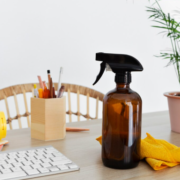It is very essential to keep a healthcare facility hygienic, fresh, and safe. Hospitals have their own exclusive sanitation requirements that cannot be handled only by basic cleaning in their operation theatres to patient wards. Bad smells, chemical traces, and microbiological contamination may have an impact on the patient comfort and staff productivity.
To have a solution to these problems, hospitals are turning to two major innovations: professional odor management system for hospitals and contracting with the supplier of green housekeeping products. These environmentally friendly solutions are combined to enhance health, sustainability and operational excellence.
The Odor Control Scourge in Hospitals.
Hospitals receive huge amounts of organic waste, disinfectants, and bio-contaminants on a daily basis – and all of them can produce strong unpleasant smells. Special attention is paid to such areas as wards, restrooms, laboratories, waste zones, and kitchen.
Traditional air fresheners are just a temporary cover-up of the smells and usually include volatile organic compounds (VOCs) that may cause allergies or respiratory distress. Conversely, a hospital specific odor control system is able to contain the odor at the source without introducing harmful chemical gases in the air.
Ordinary Healthcare Sources of Odors:
- Biological wastes and medical wastes.
- Washing chemicals and disinfectants.
- Toilets and sewage systems.
- Laundry rooms, cafeterias, and kitchens.
- Stagnant air in HVAC systems
Such smells do not only make people uncomfortable but also form a negative opinion of the quality of hygiene in hospitals.
What Is a Hospital odor management system?
An odor management system is a scientifically engineered set of solutions that is aimed at elimination of odor causing molecules by means of safe, natural, or chemical neutralizers.
It does not use masking scents as compared to the traditional air fresheners. Rather, it decomposes, oxidizes and biologically enzymatic reacts to eliminate the source of odors.
The main characteristics of a hospital odor management system are the following:
- Enzyme neutralization: neutralizes organic waste that causes smells.
- Automated diffusion or misting units: Guarantee freshness of air throughout.
- Non-toxic preparations: No harm to patients, personnel and medical settings.
- Smart sensors: Monitor and control the intensity of odors.
- Operation energy-saving: It minimizes electricity and maintenance expenditures.
Hospitals can create a more comfortable atmosphere to patients, better recovery conditions, and guarantee adherence to healthcare hygiene standards by ensuring air is kept clean on a regular basis.
Reasons to collaborate with a supplier of green housekeeping products?
A supplier of green housekeeping products offers products of sanitation and cleaning which are green, non toxic and biodegradable. All these products promote sustainable hygienic practices within the hospitals, in line with the current green building and health norms.
Fronts of Green Housekeeping Products:
- Healthier IAQ: Devoid of nasty VOCs, ammonia, and artificial fragrances.
- Eco-Safe Ingredients: They consist of biodegradable surfactants and plant-derived enzymes.
- Water and Energy Efficiency: Consume less water to rinse and low amounts of packaging waste.
- Lower Chemical Contamination: Cleaning staff and sensitized patients are safe.
- Supports Sustainability Goals: Assists hospitals in meeting the ISO 14001 and LEED certification criteria.
Hospitals get their cleaning supplies through an established green housekeeping products supplier, and they will not only be assured of both hygiene and sustainability, but they will not be losing out on safety or performance.
Combining Odor Control and Green Cleaning.
The combination of odor control and environmentally friendly cleaning is a holistic hygiene approach that provides long-term freshness and cleanliness.
The two systems are combined in the following way:
- Prevention and Neutralization: The green cleaning products destroy the bacteria and organic traces which cause the odors.
- Continuous Odor Monitoring: Odor neutralization and detection of airborne molecules with the help of automated odor systems.
- Green Function: The two systems decrease chemical wastes and enhance indoor air quality.
- Improved User Interface: Patients, employees and visitors have a safer and cleaner atmosphere in the hospital.
This is a combined method that guarantees the observable and breathable hygiene, one of the crucial elements of healthcare comfort and confidence.
Hospital Implementation Steps.
Assess Problem Areas: Determine odor prone areas like toilets, garbage areas or operation rooms.
- Select an Appropriate Odor Control System: Select bio-enzymatic/essential oil based products that are safe in hospitals.
- Collaborate with a Certified Green Supplier: Buy biodegradable cleaners, disinfectants, and hand hygienics.
- Train Housekeeping Team: Train the personnel on long-lasting cleaning practices and proper use of products.
- Routine Checkups and Inspections: Organize routine checks to make sure that the equipment is efficient and the air remains at a constant quality.
With these measures, hospitals will gain long term hygienic sustainability and odor free areas.
Influential Advantages to Healthcare Facilities.
- Increased customer contentment and gratification.
- Fresh, odor-free indoor air 24/7
- Reduced chemical footprint
- Water and energy conservation.
- Adherence to health and safety requirements.
- Green building certifications contribution.
The advantages of eco-smart hygiene are that it is not only a fad but a requirement in the current healthcare infrastructure.
FAQs
Q1. What is the primary goal of the odor management system in the hospitals?
It defuses and eliminates smelling substances in the medical wastes, toilets and air conditioning to keep the environment clean and fresh.
Q2. What is the difference between green housekeeping products and normal cleaning chemicals?
They are composed of non-toxic biodegradable materials, which clean sufficiently, without injuring humans and the environment.
Q3. Are they safe in the patient wards and in the ICUs?
Yes. Hospital grade odor management systems are non-allergenic and are based on chemical free technology and can be used in delicate locations.
Q4. Are green cleaning products able to disinfect?
Absolutely. There are a lot of environmentally friendly products that cannot be classified as less safe and harmless and do not compromise hospital sanitation effectiveness.
Q5. What are typical technologies of odor management?
Bio-enzymatic neutralization, essential oil diffusion, and smart sensor-based air purification.
Q6. What are the ways to quantify air quality improvement in hospitals?
By means of the indoor air quality (IAQ) monitoring tools which track the concentrations of VOCs, humidity, and odor strength.
Q7. Will the cost of the strategic shift to green cleaning escalate the cost of operation?
At the beginning, expenses might be equivalent or a bit higher but the saved money in the long run is because of a decrease in the use of products, energy efficiency, and the safety of staff.
Conclusion
Having a well trusted odor management system installed in a hospital and purchasing a supplier of green housekeeping products is a proactive measure to have healthier, safer and more environmentally friendly health centers.
Such green hygiene products are not only protecting patients and employees but also demonstrate a hospital culture of environmental responsibility coupled with modern hygiene.















![How to solve [pii_email_af9655d452e4f8805ebf] Error?](https://themediahubs.com/wp-content/uploads/2023/02/U9rr3rhWhUvxCSyrdw3r5MZLGTsfOGbJeliDmntx-1-1-400x225.jpg)



![How to solve [pii_email_af9655d452e4f8805ebf] Error?](https://themediahubs.com/wp-content/uploads/2023/02/U9rr3rhWhUvxCSyrdw3r5MZLGTsfOGbJeliDmntx-1-1-180x180.jpg)
Comments